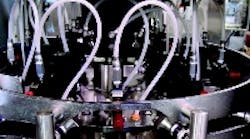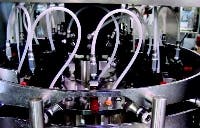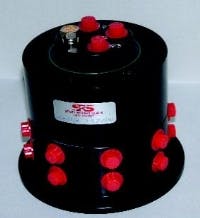Packaging engineers are constantly seeking simple, reliable, and economical solutions to their rotary processing needs. In some applications involving rotary or indexing tables, multiple devices must be actuated at different times during the 360° revolution. Examples include clamping, push rods for ejecting parts, locating devices, and air motors. Delivering compressed air to these devices at the proper time can be a complex problem, particularly as the number of work stations increases.
Having a single rotating valve that supplies and control single or multiple devices at each work station provides a simple solution. Del Packaging Solutions, Cypress, Tex., uses a rotary timing valve (RTV), manufactured by Scott Rotary Seals, Hinsdale, N. Y., in their Continuous Lid Plugging System.
The stationary component of an RTV has the timing sequence machined into the sealing surface. As the rotating outlets pass through the timing sequence, flow is automatically turned on and off depending on their orientation. The timing pattern on the interface between the stationary and dynamic sections of the valve defines the circuit.
The angular relationship of the workstation ports to the slotting arrangement automatically provides the on/off control required. This replaces conventional methods, such as using cams, solenoid valves, and switches. If an external control is needed at only one station, the valve manufacturer can provide for the external control by installing another inlet port for the function and adjust the timing slot accordingly. This eliminates the need for multiple-station control devices and also channels all control through the RTV.
As a result, piping arrangements are greatly simplified. Inlet connections can easily be brought into the machinery. The manifolded rotating ports direct compressed air from the valve to the proper workstations.
RTVs can even accommodate multiple pressures. This is done simply by adding additional input lines, so each circuit can have different pressure — or a regulator can be installed on the input lines.
Reduction of complexity, elimination of expensive multiple controls, and the minimizing of system interfacing are achieved by this one component, resulting in cost savings of 50% or more when compared to electromechanical control systems.
The RTV's simplicity also can reduce the time needed to finetune equipment performance after startup.
For more information on Scott Rotary Seals, visit their website at www.scottrotaryseals.com.



